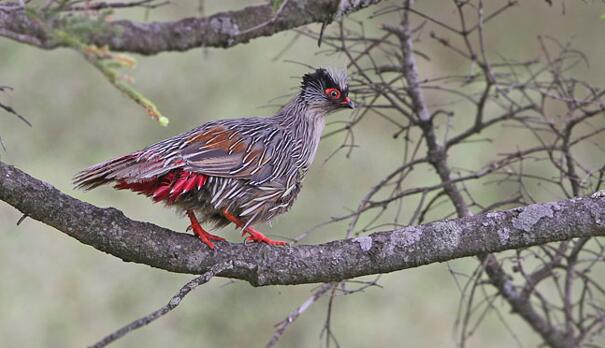The Ithaginis cruentus;blood pheasant, also referred to as the blood chicken, chicken Taebaek, Songhua chicken, or glass chicken, has not yet made an appearance in any zoos in China or internationally. Crimson-tipped plumage scattered across the belly and chest resembles droplets of blood, giving rise to the bird’s startling name. This beautifully arrayed bird is native to Ti-bet, Sichuan, northwest Yunnan and Qinghai, Gansu’s Qilian Mountains, and Shaanxi’s Qinling Mountains. They prefer altitudes of 1,800-3,200m in middle and high mountain areas. There are occasional sightings in Nepal, though this is an unusual treat for bird watchers and enthusiasts.
Though shaped similarly to domestic chickens, blood pheasants are slightly smaller weighing about 1kg. The male’s head feathers are gray with dark brown patches down the sides. The body is grayish brown with long, crimson-edged tail feathers. A green chest fades into a brownish gray in the abdominal area.
The female’s forehead, face, and throat are pale pink while the skin on the chin and eyes are light tan. Head feathers are brown with a soil gray crest behind. The upper body and wings are brown and covered with thin, black spots, but the brown lower body exhibits dark brown and wavy spots on the abdomen and under the tail. Adolescent blood pheasants resemble adult female in color.
Each year at the end of April, the blood pheasant’s habitat is still cold, windy, and covered with snow, but diet does not stop them from a dramatic mating ritual. Males, showing off their bright plumage, begin competing for mates. Brazen attacks and strutting determine which males will mate successfully. The winner swaggers proudly in front of his chosen female while she docilely stands by. At this point, they pair off and start a life together.
In early May, the females begin nesting. They choose grass, underbrush, or small caves in the depths of the slopes to create shallow pot-like nests and then line them with moss, pine needles, and feathers. Each nest is carefully arranged for maximum sun exposure. The female lays eggs every two or three days, but will not sit on the nest until there are 4-8 eggs in total. Once there are enough eggs, the female leaves the nest only once per day when she hunts for food. She never strays farther than about 20-30m and no longer than two hours on a sunny day or half an hour on a rainy day. Before leaving, she hides the nest with hay or leaves to protect it in her absence. The male is responsible for inspecting and defending the nest. He chases away any single male pheasant that might wander too dose to his nesting ground. Sub-adult blood pheasants are allowed to forage in a distance of40-50m from the nest, so the male has a difficult and big job to ensure die safety of his offspring.
After 28 or 29 days the chicks hatch and the mother stays on the nest, keeping the chicks warm and safe. The next day, the new family leaves its nest behind and embraces a nomadic li£. Both blood pheasant parents share responsibilities in rearing their offspring with a dear division of labor. The male continues on protective duty while the female sees to the nourishment of their young. If the male detects a threat, he immediately issues a sharp cry to warn his family. The chicks run away in different directions and hide in the grass or between the rocks. When the threat passes, the male signals that the coast is clear and the female echoes the call. The chicks then come out of their hiding places and return to their parents. The chicks stay dose to the mother, imitating her pecking and foraging behaviors. They soon learn to find food independently and enjoy catching beetles or delphinium leaves that they find among the underbrush.
Blood pheasants are social birds that live in groups. During the summer and fall, they stay in single-family units but by winter, many families join together to form a larger group. Each lar^ group contains anywhere from 20 to 50 blood pheasants and they stay together until 卸 ril when the mating rituals begin and new families form. Younger birds or those who did not find mates remain together in groups.
Fertility in the blood pheasant population is low and survival of the young is also dwindling. Their eggs and chicks often £tll prey to weasels, raptors, and other predators. Human destruction of their natural habitats also forces the species to relocate, sometimes to places with harsher weather. Extreme cold factors into the declining blood pheasant population. Humans hunt the pheasants for their meat and medicinal qualities, and herb collectors often pick up the eggs for human consumption.
In order to protect these rare birds, a breeding center was set up in the Shaanxi Taibai Mountain Nature Reserve, specifically dedicated to blood pheasants. During the breeding period, visitors are prohibited from entering the area. Human consumption is one large factor in the decreasing population, but at the same time, human conservation efforts are making progress toward protecting and preserving the beautiful blood pheasant for generations to come.























